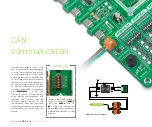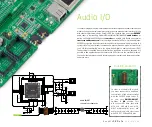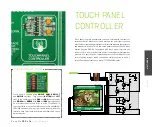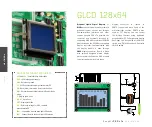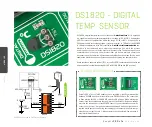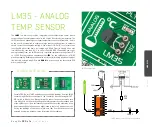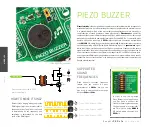
P A G E 37
E a s y M x
P R O
v 7 a
U s e r M a n u a l
1
2
3
4
5
6
7
8
O
N
SW14
R35
10K
Q1
BC846
R28
1K
VCC-5V
PE14
BUZZER
PZ1
BUZZER
DATA BUS
PERSPECTIVE
VIEW
TOP
VIEW
PIEZO BUZZER
MODULES
Piezo electricity
is the charge which accumulates in certain solid materials in response to
mechanical pressure, but also providing the charge to the piezo electric material causes
it to physically deform. One of the most widely used applications of piezo electricity is
the production of sound generators, called piezo buzzers.
Piezo buzzer
is an electric
component that comes in different shapes and sizes, which can be used to create sound
waves when provided with analog electrical signal. EasyMx PRO v7a f comes with piezo
buzzer which can be connected to
PE14
microcontroller pin. Connection is established
using
SW14.8
DIP switch. Buzzer is driven by transistor
Q1
. Microcontrollers can create
sound by generating a PWM (Pulse Width Modulated) signal – a
square wave
signal,
which is nothing more than a sequence of logic zeros and ones. Frequency of the square
signal determines the pitch of the generated sound, and duty cycle of the signal can be
used to increase or decrease the volume in the range from 0% to 100% of the duty cycle.
You can generate PWM signal using hardware capture-compare module, which is usually
available in most microcontrollers, or by writing a custom software which emulates the
desired signal waveform.
Piezo buzzer’s resonant frequency
(where you can expect it's best
performance) is
3.8kHz
, but you can
also use it to create sound in the range
between
2kHz
and
4kHz
.
SUPPORTED
SOUND
FREQUENCIES
Piezo buzzer connected to PE14
microcontroller pin
Enabling Piezo Buzzer
Buzzer starts "singing" when you provide
PWM signal from the microcontroller to
the buzzer driver. The pitch of the sound
is determined by the frequency, and
amplitude is determined by the duty
cycle of the PWM signal.
HOW TO MAKE IT SING?
Freq = 3kHz, Duty Cycle = 50
%
Freq = 3kHz, Duty Cycle = 80
%
Freq = 3kHz, Duty Cycle = 20
%
Freq = 3kHz, Volume = 50
%
Freq = 3kHz, Volume = 80
%
Freq = 3kHz, Volume = 20
%
TO SOCK
ETS
VCC-5V
R3
1K
PZ1
Q8
BC846
10K
R27
PERSPECTIVE
VIEW
TOP
VIEW
RE1
RC2
J21
BUZZER
TO SOCK
ETS
VCC-5V
R3
1K
PZ1
Q8
BC846
10K
R27
PERSPECTIVE
VIEW
TOP
VIEW
RE1
RC2
J21
BUZZER
TO SOCK
ETS
VCC-5V
R3
1K
PZ1
Q8
BC846
10K
R27
PERSPECTIVE
VIEW
TOP
VIEW
RE1
RC2
J21
BUZZER
PIEZO BUZZER module view
In order to use the on-board
Piezo Buzzer in your application,
you first have to connect the
transistor driver of piezo buzzer to
the appropriate microcontroller
pin. This is done using
SW14.8
DIP switch which connects it to
PE14
pin.



